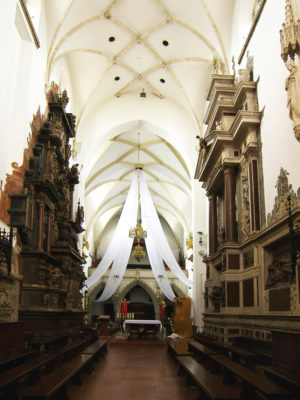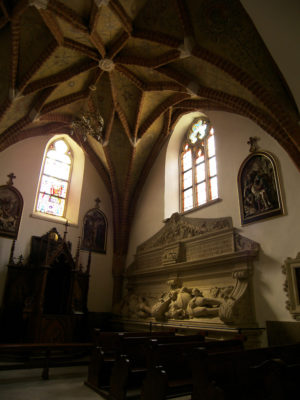
The Cathedral, raised to the status of Minor Basilica in 1972, is the most impressive of all monuments in Tarnów. The original 14th century Gothic building was presumably made of brick and stone, with one nave and a rectangular apse. It was quite a large structure even though had no tower.
First written information on the church date back to 1346. In 1400 the church became a collegiate. Consequently, between the end of the 14th century and the 19th century the original building of the Nativity of the Blessed Virgin Mary parish church was supplemented with chapels. Tower was adjusted to the nave at the end of the 15th century, after the fire of 1494.
Nowadays the tower reaches 72 meters into the sky, but its original size remains unknown. In 1810 part of the tower was pulled down to the roof level for the reconstruction works that lasted until 1891.
The collegiate church was raised to be the Cathedral in 1786, when a diocese in Tarnów was established. Even though Pope Pius VII repealed the decision in 1805, the diocese was restored twenty-one years later.

After 1826 the church was again rebuilt during the rule of Bishop Grzegorz Zieler – the northern and southern chapels were connected with the nave by arcades, creating two aisles.
St Benedict’s chapel (its name was changed to Blessed Sacrament chapel) was built on the southern side next to the apse. The external walls were covered with plaster. The northern side of basilica was adjusted with treasury and vestry rooms.
The Cathedral was given the present neo-Gothic style following the thorough renovation works and a partial reconstruction in years 1889-1900. The interior of Basilica is impressive with well-preserved pieces of stonework and woodwork. Gothic-Renaissance tombstones of the Tarnowski family and Baroque one of the Ostrogski family, considered the most remarkable works of art in Poland were created by masters such as Bartolomeo Berecci, Giovanni Maria Padovano and Jan Pfister.

Berecci’s tombstone of Barbara Tarnowska (maiden name Tęczyńska) is considered the most beautiful Renaissance sculpture of a woman in Poland. The tombstone of Tarnowski family, created by Padovano, is the most monumental Renaissance monument in Poland – over 13.8 meter high and 5.6 meter wide. Superior furnishings with beautifully ornamented clergy stalls, altars, sculptures, epitaphs, paintings and stained glass place Tarnów Cathedral among the greatest temples in Poland.
Outside the Cathedral stands the first, created in 1981, monument of Polish Pope John Paul II in the world.
In the backstreet, behind the Cathedral Mikołajowski House is located. It is one of the most beautiful and oldest, built in 1524, tenement houses in Tarnów. Diocese Museum, which is located in this house, has a unique exhibit, original alter from a UNESCO listed church in Lipnica Murowana.